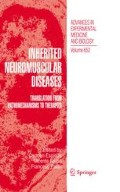Abstract
Pompe disease is a rare autosomal recessive lysosomal storage disease caused by deficiency of acid-a-glucosidase (GAA). This deficiency results in glycogen accumulation in the lysosomes, leading to lysosomal swelling, cellular damage and organ dysfunction. Patient age at the onset of Pompe disease symptoms and the rate of deterioration can vary considerably.
In early onset patients (the classical infantile form) this glycogen accumulation leads to death usually before the age of 1 year. Some patients with early onset don’t develop cardiomiopathy and their progression is slower (atypical infantile form). The late-onset form (juvenile and adult forms) have more slow and variable course. The gene is localized in 17q25. More than 200 different mutations have already been described. Diagnosis has been classically made by mean of muscular biopsy. Nowadays is more convenient the screening of GAA in dried blood sample followed by GAA assessment in lymphocytes or fibroblasts or by the genetic study of mutations.
Besides non specific multiprofesional management, since 2006 there is a specific enzyme replacement therapy (ERT), Myozyme®), which compensates for the missing enzyme by i.v. administration of recombinant produced enzyme.
In classic Pompe disease the reported results improve significantly the survival, the motor development and the cardiac function. The sooner ERT starts, the better are the results.
In late onset Pompe disease ERT has also demonstrated significant improvement in muscular function and quality of life.
Access this chapter
Tax calculation will be finalised at checkout
Purchases are for personal use only
References
Amalfitano A, Bengur AR, Morse RP, et al. Recombinant human acid alpha-glucosidase enzyme therapy for infantile glycogen storage disease type II: results of a phase I/II clinical trial. Genet Med 2001; 3:132–138.
An Y, Young SP, Kishnani PS, et al. Glucose tetrasaccharide as a biomarker for monitoring the therapeutic response to enzyme replacement therapy for Pompe disease. Mol Genet Metab 2005; 85:247–254.
Bijvoet AG, Van Hirtum H, Kroos MA, et al. Human acid alphaglucosidase from rabbit milk has therapeutic effect in mice with glycogen storage disease type II. Hum Mol Genet 1999; 8:2145–2153.
Chamoles NA, Niizawa G, Blanco M, et al. Glycogen storage disease type II: enzymatic screening in dried blood spots on filter paper. Clin Chim Acta 2004; 347:97–102.
Gort L, Coll MJ, Chabás A. Glycogen storage disease type II in Spanish patients: high frequency of c.1076-1G>C mutation. Mol Genet Metab 2007; 92:183–187.
Hawes ML, Kennedy W, O’Callaghan MW, et al. Differential muscular glycogen clearance after enzyme replacement therapy in a mouse model of Pompe disease. Mol Genet Metab 2007; 91:343–351.
Hirschhorn R, Reuser AJJ. Glycogen storage disease type II: acid alpha-glucosidase (acid maltase) deficiency. In: Childs B, et al., eds. The Metabolic and Molecular Bases of Inherited Disease, 8th ed. New York: McGraw-Hill; 2000: pp. 3389–3420.
Kishnani P, Corzo D, Nicolino M, et al. Recombinant human acid alpha-glucosidase: major clinical benefits in infantile-onset Pompe disease. Neurology 2007; 68:99–109.
Kishnani PS, Howell RR. Pompe disease in infants and children. J Pediatr 2004; 144:S35–S43.
Kishnani PS, Hwu WL, Mandel H, et al. A retrospective, multinational, multicenter study on the natural history of infantile-onset Pompe disease. J Pediatr 2006a; 148:671–676.
Kishnani PS, Nicolino M, Voit T, et al. Chinese hamster ovary cell-derived recombinant human acid-glucosidase in infantile-onset Pompe disease. J Pediatr 2006b; 149:89–97.
Koeberl DD, Kishnani PS, Chen YT. Glycogen storage disease types I and II: treatment updates. J Inherit Metab Dis 2007; 30:159–164.
Kroos MA, Pomponio RJ, Hagemans ML, et al. Broad spectrum of Pompe disease in patients with the same c.-32-13T->G haplotype. Neurology 2007; 68:110–115.
Müller-Felber W, Horvath R, Gempel K, et al. Late onset Pompe disease: clinical and neurophysiological spectrum of 38 patients including long-term follow-up in 18 patients. Neuromuscul Disord 2007; 17:698–706.
Slonim A, Boone L, Minikes J, et al. Benign course of glycogen storage disease type II in two brothers: nature or nurture? Muscle Nerve 2006; 33:571–574.
van Den HH, Reuser AJ, Vulto AG, et al. Recombinant human alpha-glucosidase from rabbit milk in Pompe patients. Lancet 2000; 356:397–398.
van den Hout HMP, Hop W, van Diggelen OP, et al. The natural course of infantile Pompe’s disease: 20 original cases compared with 133 cases from the literature. Pediatrics 2003; 112:332–340.
Winkle LPF, Kamphoven JHJ, van den Hout HMP, et al. Morphological changes in muscle tissue of patients with infantile Pompe’s disease receiving enzyme replacement therapy. Muscle Nerve 2003; 27:743–751.
Young SP, Corzo D, Kishnani P, et al. Diagnostic value of urinary and plasma glucose tetrasaccharides in infantile and late onset glycogen storage disease type II. Mol Genet Metab 2005; 84:241–242.
Author information
Authors and Affiliations
Corresponding author
Editor information
Editors and Affiliations
Rights and permissions
Copyright information
© 2009 Springer Science+Business Media B.V.
About this chapter
Cite this chapter
Pascual, S.I.P. (2009). Phenotype Variations in Early Onset Pompe Disease: Diagnosis and Treatment Results with Myozyme®. In: Espinós, C., Felipo, V., Palau, F. (eds) Inherited Neuromuscular Diseases. Advances in Experimental Medicine and Biology, vol 652. Springer, Dordrecht. https://doi.org/10.1007/978-90-481-2813-6_4
Download citation
DOI: https://doi.org/10.1007/978-90-481-2813-6_4
Published:
Publisher Name: Springer, Dordrecht
Print ISBN: 978-90-481-2812-9
Online ISBN: 978-90-481-2813-6
eBook Packages: Biomedical and Life SciencesBiomedical and Life Sciences (R0)

